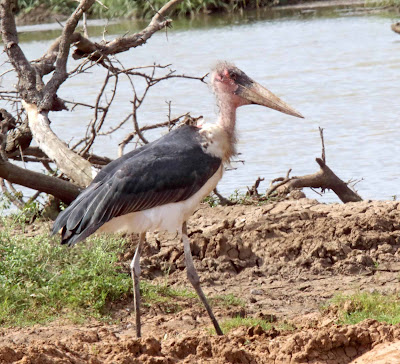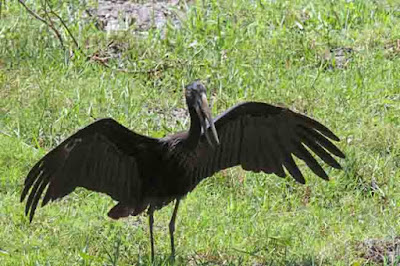As usual my birding luck was 100% and we saw almost every thing expected to be found and many that were not expected!
We saw several storks on the trip which was nice, as we have only a single species in North America. The 45" Woolly-necked Stork (Ciconia episcopus) has a black body, white fluffy neck, blackish head and dark bill tipped with red.
 |
| Woolly-necked Stork |
If the old tales we were told as kids are true, that storks brought the babies to the house, this ugly stork would not be the one you would want. The 60" Marabou Stork (Leptoptilos crumenifer) has a dark back, white undersides bare red skin on head like a vulture. This is a juvie with the downy feathers on his neck
 |
| Marabou Stork |
The unusual 35" African Openbill (Anastomus lamelligerus) is all black and is named for the fact that when his bill is closed, there is a gap between mandibles in the middle. You will notice the curve in the lower mandible in the photo.
 |
| African Openbill |
Next is the beautiful 40" Yellow-billed Stork (Mycteria ibis). It is white with some black on the wings, red face and legs, and a bright yellow bill.
 |
| Yellow-billed Stork |
The last one is the most amazingly colored of all. The 60" male Saddle-billed Stork (Ephippiorhynchus senegalensis) is an easy ID once you see him. We only saw a pair of these storks once on the trip. The female is similar but duller.
 |
| Saddle-billed Stork - male |
One of the nice things these reserves in South Africa provide is many bird blinds or as they call them 'hides'. The Saddle-billed Stork above was taken from one of them as well as this 40" Gray Heron (Ardea cinerea). I had seen him from afar in Hong Kong before.
 |
| Gray Heron |
Likewise I got my best photo of a 17" Striated Heron (Butorides striata). I had photographed this one before in South America.
 |
| Striated Heron |
The 20" Western Cattle Egret (Bubulcus ibis) arrived in the New World from Africa in the 1930s and is very common now, but sitting in a blind and this one in full breeding plumage with his orange feathers above me. I just had to take his photo taken and is my best photo of this species.
 |
| Western Cattle Egret |
I found 2 new species for lifers. The 36" Black-headed Heron (Ardea melanocephala). It is similar to the Gray Heron above, but the back of the neck and top of head are black.
 |
| Black-headed Heron |
 |
| Squacco Heron |
I also saw the Black Heron, but he was too far away for a useful photo and I missed the one I really wanted to see, the huge 60" Goliath Heron.
Continued on Part 2
Continued on Part 2
No comments:
Post a Comment